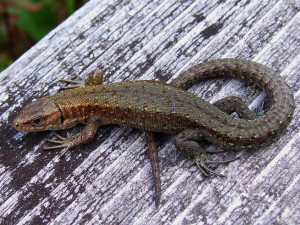Viviparous lizard
 This is the most widespread species both in its genus and the entire family of the lacertian. The newly born viviparous lizards are dark-brown or nest to black, often with no pattern at all. As they grow, the coloration gradually becomes lighter, and in time a peculiar pattern comes through made up from a dark fine dorsal line, two light stripes on the sides of the back and fairly broad dark bars on the sides of the body. Besides, small dark spots are chaotically scattered all over the body. The under parts are orange or brick-red in adult males, and whitish grey, yellowish or greenish in females. Completely black species can also be encountered. Viviparous lizards do not exceed 15-18 cm in length, with over half of that being the tail, somewhat bulbous at base in males. The viviparous lizard sticks to humid habitats, dwelling in wooded marshes, peat bogs, overgrowing logging sites, forest edges and cleared strips, in deciduous and coniferous tree nurseries, bushy banks of streams and canals etc. It preys on various insects, spiders, mollusks and worms, hunting both on the ground, grass and tree trunks. Compared to all other species of its genus, this lizard is live-bearing. Its pregnancy lasts for about 90 days, and the young (8-12) emerge in mid-July through late August. They reach sexual maturity in the third year of life, when 75-80 mm long.
This is the most widespread species both in its genus and the entire family of the lacertian. The newly born viviparous lizards are dark-brown or nest to black, often with no pattern at all. As they grow, the coloration gradually becomes lighter, and in time a peculiar pattern comes through made up from a dark fine dorsal line, two light stripes on the sides of the back and fairly broad dark bars on the sides of the body. Besides, small dark spots are chaotically scattered all over the body. The under parts are orange or brick-red in adult males, and whitish grey, yellowish or greenish in females. Completely black species can also be encountered. Viviparous lizards do not exceed 15-18 cm in length, with over half of that being the tail, somewhat bulbous at base in males. The viviparous lizard sticks to humid habitats, dwelling in wooded marshes, peat bogs, overgrowing logging sites, forest edges and cleared strips, in deciduous and coniferous tree nurseries, bushy banks of streams and canals etc. It preys on various insects, spiders, mollusks and worms, hunting both on the ground, grass and tree trunks. Compared to all other species of its genus, this lizard is live-bearing. Its pregnancy lasts for about 90 days, and the young (8-12) emerge in mid-July through late August. They reach sexual maturity in the third year of life, when 75-80 mm long.
/ * The photos at lake.peipsi.org are cross-posted from commons.wikimedia.org and are used for familiarization purposes only. No commercial use of the photos is allowed. For more information about to use the photos see the originals on commons.wikimedia.org. /


